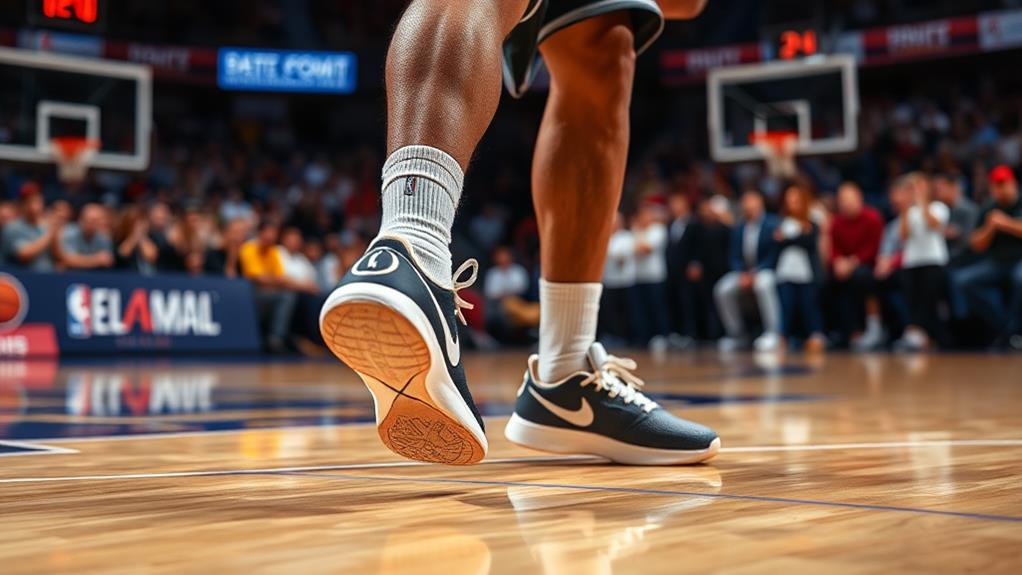
Mastering the Pivot Foot in Basketball: Techniques and Tips
November 14, 2024Mastering your pivot foot is essential for enhancing your basketball performance. It provides stability and control, allowing you to make effective offensive moves while preventing traveling violations. Focus on keeping your pivot foot grounded until you execute a move, and practice pivoting with both feet for versatility. Use drills that improve foot placement and dynamic balance, as these are key to successful pivots. Stay aware of legal movements to avoid violations and enhance decision-making under pressure. As you refine these techniques, you'll reveal advanced skills that could elevate your game even further.
Importance of the Pivot Foot
The pivot foot is integral for every basketball player, as it provides the stability and control needed to execute offensive moves effectively. Establishing a solid pivot foot allows you to spin or change direction without fear of committing a traveling violation.
When you pick up your dribble, grounding your pivot foot becomes essential to maintaining your balance and keeping the play alive. Utilizing proper cardio workouts can also enhance your overall agility, which complements your pivoting skills on the court.
Using the pivot foot effectively can free you up for shooting, passing, or dribbling, all crucial skills for offensive gameplay. It's not just about movement; it's about making smart decisions under pressure.
By mastering your pivot foot, you enhance your ability to assess the court and create strategic plays, which can be the difference between scoring and turning the ball over.
Elite players like Kobe Bryant and Hakeem Olajuwon exemplify the importance of the pivot foot, using it to create space for scoring opportunities. Their techniques show how mastery of this fundamental aspect of ball handling can elevate your game.
Understanding Pivoting Techniques
Mastering pivoting techniques can greatly elevate your basketball game. Pivoting allows you to change direction quickly while maintaining control of the ball, which is absolutely vital in today's fast pace of play.
Incorporating advanced footwork practices can further enhance your pivoting skills and overall gameplay. To execute effective pivots, always make sure your pivot foot is planted until you complete your move. This prevents traveling violations and keeps you stable.
For young players, practicing on both the right foot and the left foot is essential. This adaptability will enable you to create space for shooting or passing under defensive pressure.
Incorporate Basketball Drills that focus on pivoting to enhance your skills. As you practice pivoting, you'll notice improvements in your ability to perform advanced footwork, such as spin dribbles and up-and-under shots.
Footwork Fundamentals for Success
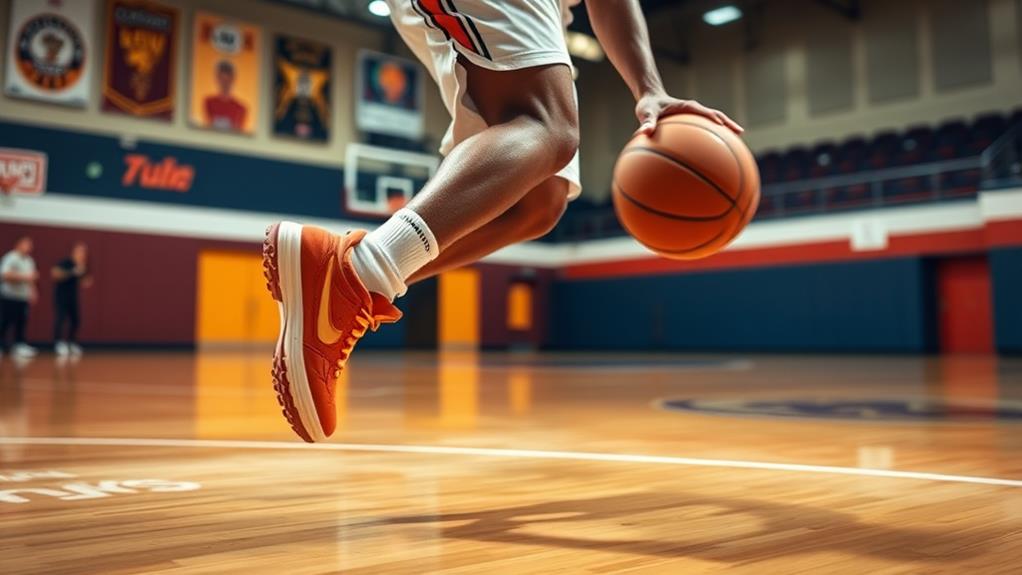
Footwork fundamentals lay the groundwork for your success on the basketball court. For basketball players, polished footwork is essential, especially when it comes to pivoting.
Mastering these techniques can greatly enhance your offensive efficiency and overall gameplay strategy, similar to how fundamental techniques and accuracy in passing can improve a soccer player's performance.
To develop your footwork skills, consider focusing on the following drills:
- Stationary pivots: Practice pivoting without moving to build strength and balance.
- Right/left front pivots: Work on pivoting in both directions to become versatile.
- Reverse pivots: Improve your ability to change direction quickly.
- Foot placement: guarantee your feet are properly aligned to maintain balance.
- Dynamic balance drills: Incorporate exercises that challenge your stability while moving.
Rules of Pivoting in Basketball
When you're pivoting, it's crucial to keep your pivot foot stable until you decide to shoot, pass, or dribble.
Understanding the importance of data-driven strategies can enhance your decision-making on the court, allowing you to execute moves with precision.
Knowing the legal movement techniques can help you maneuver effectively while avoiding common violations.
Maintaining Pivot Foot Stability
To maintain pivot foot stability, it's essential to keep that foot firmly planted on the floor while you control the ball. This stability allows you to execute your moves effectively, enhancing your overall performance.
Once you establish your pivot foot, remember that you can't change it until you shoot, pass, or start dribbling. Proper rotation around your pivot foot is important for maintaining balance and improving your shot's power and accuracy.
Here are some balance techniques to help you maintain pivot foot stability:
- Keep your knees slightly bent for lower center of gravity.
- Distribute your weight evenly over your pivot foot.
- Use your non-pivot foot to create space and help with balance.
- Practice quick, controlled footwork to enhance your agility.
- Focus on your core strength to support stability during movements.
Legal Movement Techniques
Understanding the rules of pivoting is essential for maximizing your effectiveness on the court. When you establish your pivot foot, it must stay planted until you execute a move. This guarantees you maintain stability and control while possessing the ball.
Remember, once you've established your pivot foot, you can't change it unless you dribble or pass. This rule helps you avoid traveling violations.
You can legally free your pivot foot by shooting, passing, or dribbling, which opens up various offensive strategies. If you decide to jump before passing, make sure to release the ball before you land. This move can create dynamic plays and keep defenders guessing.
Proper pivot footwork enhances your shot power and accuracy. When you rotate your pivot foot effectively, you not only improve your balance but also set yourself up for scoring opportunities.
Always practice these legal movement techniques to refine your skills and increase your impact on the game. Mastering the rules of pivoting will elevate your overall gameplay, making you a more versatile and dangerous player on the court.
Common Pivoting Violations
Pivoting violations can quickly undermine your performance on the court. To excel in basketball, you must master the rules surrounding pivot footwork. Here are some common violations to keep in mind:
- Traveling: Moving your pivot foot before passing, shooting, or dribbling is a violation.
- Changing Pivot Foot: Once you establish a pivot foot, you can't switch it; always rotate around it for direction changes.
- Jumping and Landing: You can jump before passing, but be sure to release the ball before you land to avoid traveling.
- Failure to Rotate Properly: Not rotating your foot correctly can lead to turnovers or fouls, impacting your gameplay.
- Improper Foot Placement: Verify your pivot foot is planted and stable during play, as shifting it can result in a violation.
Understanding these common pivoting violations will enhance your effectiveness on the court. By adhering to proper pivot footwork, you'll not only avoid penalties but also improve your overall game strategy.
Stay focused, practice these techniques, and you'll see significant improvements in your performance!
Common Mistakes to Avoid
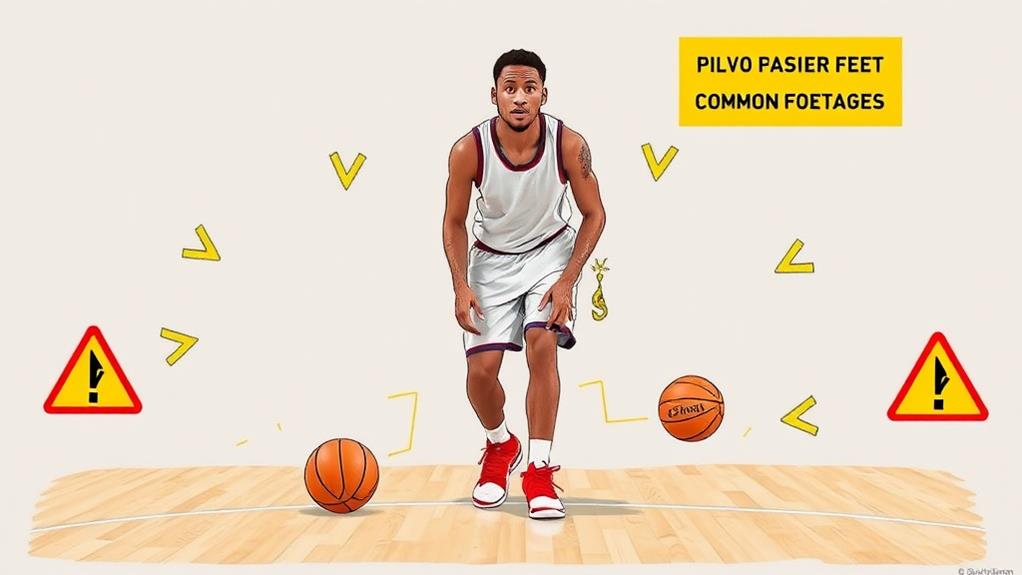
When mastering the pivot foot in basketball, avoiding a few common mistakes can make a significant difference in your performance. One major error is twisting only your upper body during pivots. This can lead to loss of balance and control, so make sure your feet are actively engaged in the movement.
The importance of character development in sports, as emphasized by the YMCA, highlights how mastering fundamental techniques like the pivot foot contributes to overall growth. Also, don't forget to keep your pivot foot planted until you execute your move; neglecting this can lead to traveling violations and costly turnovers.
Another mistake is bending down while pivoting, which can destabilize your posture. Always maintain an upright position for better control and awareness. Keeping your head up is essential during pivots as it allows you to stay aware of teammates and defenders, enabling you to make better strategic decisions.
Lastly, focus on proper footwork. Incorrect positioning can compromise your stability and effectiveness on the court, potentially leading to falls or injuries.
Teaching Pivoting Skills
Mastering the pivot foot opens the door to teaching valuable pivoting skills that can elevate a player's game. Start by emphasizing the importance of maintaining a stable pivot foot while allowing the other foot to move freely. This foundation is essential for effective pivot footwork.
Effective pivoting can be enhanced by understanding how it relates to defensive strategies that require quick foot movement and adaptability. Use visualization aids like cones to demonstrate the ideal 180-degree movement range during pivots, reinforcing spatial awareness on the court.
Incorporate these key techniques into your drills:
- Begin with slow, deliberate movements without a ball to build muscle memory.
- Progress to incorporating both right and left front and reverse pivots as comfort increases.
- Highlight the triple threat position during pivoting drills, ensuring players keep their eyes up.
- Design game-like scenarios, such as Diamond Passing and Passing Tag, to simulate pressure.
- Encourage consistent practice to make pivoting skills a natural part of gameplay.
Control Through Pivoting
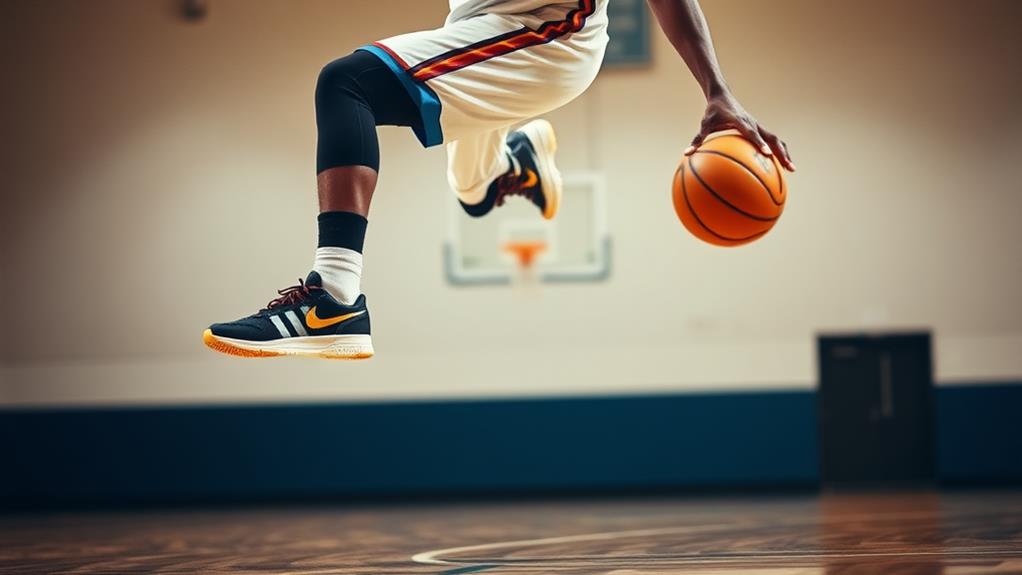
When you control your pivot, you greatly reduce game mistakes and improve your decision-making on the court. This skill not only boosts your confidence under pressure but also helps you think strategically about your next move.
Mastering pivoting allows centers to effectively utilize their size and skills to create space for shooting or passing, making you a more effective player.
As seen in the evolution of the center position, the ability to pivot can enhance overall team dynamics by facilitating ball movement and creating mismatches on the court offensive versatility and mismatches.
Reducing Game Mistakes
Effective pivoting can greatly reduce game mistakes, allowing you to maintain control and make better decisions on the court. When you master pivoting, you can stop, assess the situation, and avoid rushed choices that often lead to turnovers.
This skill is especially essential in high-pressure scenarios where mental resilience is key.
Here are some benefits of controlled pivoting:
- Enhances your ability to remain calm under pressure.
- Improves your overall basketball IQ.
- Reduces the risk of traveling violations.
- Allows for better strategic decision-making.
- Contributes to fewer mistakes during gameplay.
Strategic Decision-Making
Controlled pivoting not only reduces mistakes but also enhances your ability to make strategic decisions on the court. When you pivot effectively, you can stop and evaluate the situation without the immediate pressure of defenders closing in. This moment of composure is essential for tapping into the nuances of Decision Dynamics, allowing you to weigh your options carefully.
By mastering controlled pivoting, you minimize the risk of traveling violations and turnovers, which often stem from rushed decisions. Instead, you create opportunities for effective passing or shooting. This ability to maintain your balance while evaluating the court opens up avenues for smarter plays that can outmaneuver defenders.
Moreover, as you develop strong pivoting skills, you'll find you can read defensive movements more effectively. This insight allows you to adjust your plays on the fly, making you a more adaptable and strategic player.
Ultimately, the mastery of pivoting greatly contributes to your overall basketball IQ, empowering you to respond to various game situations with confidence and precision. Embrace controlled pivoting, and watch your decision-making elevate your game to new heights.
Enhancing Player Confidence
Through the art of pivoting, you can greatly boost your confidence on the basketball court. Controlled pivoting allows you to stop, assess your options, and make decisions without rushing. This skill notably decreases the likelihood of traveling violations, which many young players struggle with.
By mastering your pivot foot, you can effectively protect the basketball from defenders, leading to strategic gameplay and fewer turnovers.
Here's how pivoting enhances your confidence:
- Improved decision-making: A stable position allows you to read the game better.
- Less pressure: You'll feel more composed when faced with defensive challenges.
- Fewer mistakes: Reducing rushed decisions leads to more successful plays.
- Increased control: You can dictate the pace of the game and your movements.
- Enhanced basketball IQ: You'll learn to recognize opportunities as they arise.
Advanced Skills Built on Pivoting
While mastering the pivot foot is fundamental for foundational skills, it also releases advanced techniques that can greatly elevate your game. Once you've honed your pivoting strategies, you'll find yourself able to execute spin moves and deceptive fakes that keep defenders guessing.
Consistent effort is vital for refining skills, allowing you to create space and scoring opportunities. These skills are vital for effective offensive play, allowing you to create space and scoring opportunities.
Take the up-and-under move, for example. This technique relies heavily on your ability to pivot effectively, helping you create separation from defenders. The quicker your pivot, the better your chances of getting an open look at the basket.
As you develop this skill, you'll notice your basketball IQ improving, enabling you to make smarter and quicker decisions during games.
Look to elite players like Kobe Bryant and Hakeem Olajuwon for inspiration. Their mastery of pivoting led to countless scoring opportunities and helped them dominate on the court.
Before diving into these complex maneuvers, confirm you've built a strong foundation in pivot foot technique. This solid skillset is fundamental for your growth and success in basketball, setting you up for future advancements.
Community Engagement for Improvement
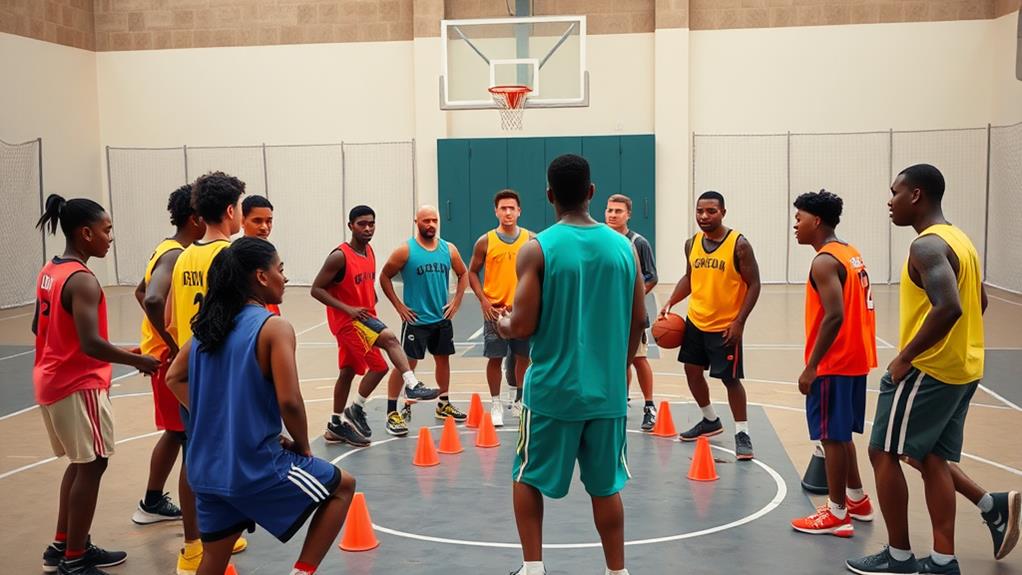
Engaging with your local basketball community can greatly enhance your pivoting skills and overall game. By immersing yourself in community collaboration, you gain access to experienced players and coaches who can offer valuable insights into mastering your pivoting techniques.
This engagement can also promote inclusivity and equality in sports by bringing together players from diverse backgrounds. Participating in community events and training sessions provides hands-on practice, allowing you to improve your skills in a supportive environment.
Here are some ways to get involved:
- Join local basketball leagues or clubs to connect with fellow players.
- Attend community training sessions for personalized guidance on pivoting.
- Share tips and strategies with teammates to deepen your understanding.
- Engage in discussions about pivoting challenges to foster learning.
- Participate in drills that focus specifically on pivoting techniques.
Game Situation Drills for Practice
Mastering pivoting skills in game situations is crucial for elevating your basketball performance. To enhance your abilities, incorporate drill variations that simulate real-game scenarios. Understanding basic rules and structure of soccer can also improve your overall awareness on the court.
Start with "Diamond Passing," where you pivot to receive passes while keeping an eye on your teammates and the defense. This drill sharpens your footwork under pressure and improves your overall awareness.
Next, try "Passing Tag" exercises. In this drill, you'll need to pivot effectively while dodging a defender, reinforcing your pivoting skills in dynamic situations. This not only challenges your footwork but also your agility.
Implement "Game Scenario Scrimmages" to practice pivoting in realistic contexts. These scrimmages encourage quick decision-making and adaptability, essential traits for any player. Focus on pivoting in various directions—right, left, front, and reverse—to develop versatility and confidence.
Lastly, emphasize maintaining a low center of gravity while pivoting. This technique enhances your balance and control during fast-paced gameplay.
Conclusion
So, you've mastered your pivot foot, right? Congratulations! Now you can spin like a ballerina while the defender's left wondering if they're watching basketball or a dance recital. Just remember, if you're not careful, you might end up pivoting your way right out of bounds. Keep practicing, avoid those common mistakes, and soon enough, your footwork will be so smooth that even the floor might start to envy your moves. Now go show off those fancy pivots!


